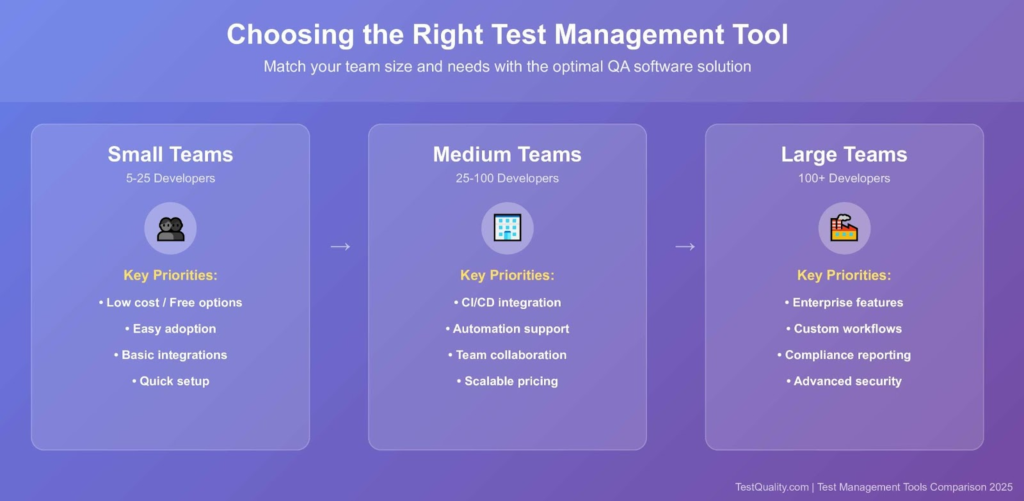Key Takeaways
The global software testing market reached $55.6 billion in 2024 and organizations using agile methodologies now represent 97% of the development landscape.
- Integration capabilities with GitHub, Jira, and CI/CD pipelines determine long-term success
- Unified platforms that handle both manual and automated testing provide better ROI than point solutions
- Freemium test planning tools offer risk-free evaluation of core functionality before full commitment
- Modern user interfaces significantly impact adoption rates and daily productivity across QA teams
The most effective platforms distinguish themselves by combining powerful integrations, intuitive design, and a flexible test plan builder that transforms how teams approach quality assurance.
The software testing market has exploded to $55.6 billion in 2024 and is projected to reach $145.84 billion by 2037, driven by organizations implementing shift-left testing practices to catch defects early when they're most cost-effective to address. Yet many teams still struggle with fragmented testing processes, using spreadsheets for test plans while juggling separate tools for execution, reporting, and defect tracking.
Modern test management tools serve as the central nervous system for quality assurance, coordinating everything from test case creation to results analysis. With 97% of organizations now using agile methodologies to some extent, choosing the right solution can make the difference between streamlined testing workflows and chaotic quality processes.
What Makes a Test Management Tool Worth Your Investment?
The best QA software platforms share certain characteristics that separate industry leaders from lesser alternatives. Understanding these criteria helps teams evaluate options objectively rather than getting swayed by marketing promises.

Seamless Integration Architecture forms the foundation of effective test management. Tools that integrate natively with GitHub for version control and Jira for issue tracking eliminate context switching that kills productivity. The most valuable platforms also connect with automation frameworks like Selenium and Playwright, allowing teams to import results directly from CI/CD pipelines.
Unified Testing Approach distinguishes modern platforms from legacy solutions. Instead of treating manual and automated testing as separate activities, leading tools provide a single interface for managing both approaches. This unified view helps teams understand overall test coverage and identify gaps that might otherwise slip through the cracks.
Intuitive User Experience directly impacts adoption rates across development and QA teams. Complex interfaces that require extensive training create bottlenecks, while modern, clean designs encourage broader participation in testing activities. The best tools feel familiar to users within minutes rather than requiring weeks of onboarding.
Flexible Test Planning Capabilities enable teams to create structured, reusable test strategies. Advanced platforms often feature innovative test plan builders, with some even offering completely free options to remove barriers to adoption and allow risk-free evaluation.
The Top 10 Test Management Tools for 2025
1. TestQuality - Unified Test Management for Modern Teams
TestQuality has positioned itself as the test management platform purpose-built for GitHub and Jira workflows. Unlike traditional tools that treat integrations as afterthoughts, TestQuality's architecture centers on live integration with developer tools that teams already use daily.
The platform's standout feature is its completely free Test Plan Builder, which allows teams to create and share comprehensive test documentation without any cost barriers. This freemium approach lets organizations evaluate core functionality before committing to paid features, reducing procurement risk significantly.
TestQuality's unified approach handles manual test execution, automation result aggregation, and requirements traceability in a single interface. The modern UI design emphasizes speed and clarity, helping teams navigate complex testing scenarios without getting lost in confusing menus or outdated interfaces.
Key Strengths: Native GitHub/Jira integration, free test planning, modern UX design, unified manual/automated testing
Best For: Development teams using GitHub workflows, organizations wanting integrated test management
Pricing: Free test planning forever, paid test management starts at affordable team rates

2. TestRail - Enterprise-Grade Test Case Management
TestRail remains the most widely recognized name in test management, with extensive customization options and enterprise-level scalability. The platform offers comprehensive test case organization, detailed reporting capabilities, and robust API integrations that support complex workflows.
The tool excels in highly regulated industries where audit trails and compliance documentation are critical. TestRail's template system and custom fields allow teams to adapt the platform to specific methodologies and regulatory requirements.
However, TestRail's interface feels dated compared to modern alternatives, and the extensive customization options can overwhelm smaller teams. The pricing structure also tends to favor large enterprises over growing development teams.
Key Strengths: Enterprise scalability, extensive customization, strong reporting, compliance features
Best For: Large enterprises, regulated industries, teams needing heavy customization
Pricing: Premium pricing starting around $37/user/month
3. Zephyr - Jira-Native Testing Integration
Zephyr operates as a native Jira application, making it an obvious choice for teams already invested in the Atlassian ecosystem. This tight integration means test cases, requirements, and defects all live within the same platform, creating seamless traceability.
The tool provides solid test execution capabilities and integrates well with automation frameworks. Zephyr's reporting features leverage Jira's dashboard capabilities, allowing teams to create comprehensive quality dashboards alongside project metrics.
The main limitation is that Zephyr's capabilities are constrained by Jira's interface and structure. Teams wanting a modern testing experience may find the Jira environment limiting compared to purpose-built test management platforms.
Key Strengths: Native Jira integration, familiar interface for Jira users, centralized project data
Best For: Teams heavily invested in Atlassian tools, organizations prioritizing single-platform workflows
Pricing: Subscription model tied to Jira licensing
4. PractiTest - Comprehensive QA Platform
PractiTest offers an end-to-end QA management platform that extends beyond basic test management to include requirements analysis and release planning. The tool's dashboard capabilities provide excellent visibility into testing progress and quality metrics.
The platform handles both manual and automated testing workflows effectively, with strong integration capabilities for popular automation frameworks. PractiTest's reporting engine generates detailed insights that help teams identify trends and optimize testing processes.
While comprehensive, PractiTest can feel overwhelming for teams seeking straightforward test management. The extensive feature set comes with complexity that may exceed smaller teams' needs.
Key Strengths: Comprehensive QA coverage, excellent dashboards, strong automation integration
Best For: QA-centric organizations, teams needing extensive reporting and analytics
Pricing: Mid-tier pricing with multiple plan options
5. Xray - Jira-Embedded Testing Solution
Xray provides test management capabilities directly within Jira, creating a completely integrated development and testing environment. For teams that want all project activities in a single platform, Xray offers compelling benefits.
The tool supports both manual and automated testing, with particular strength in requirement-to-test traceability. Xray's BDD support helps teams implement behavior-driven development practices within familiar Jira workflows.
The main trade-off is that teams are locked into Jira's interface and limitations. Organizations seeking modern testing experiences or those not using Jira may find better options elsewhere.
Key Strengths: Complete Jira integration, requirement traceability, BDD support
Best For: Jira-centric teams, organizations prioritizing unified project management
Pricing: Atlassian Marketplace pricing model
6. TestLink - Open Source Testing Platform
TestLink offers a completely free, open-source alternative for teams with limited budgets or specific customization needs. The platform provides core test management functionality including test case organization, execution tracking, and basic reporting.
Being open source, TestLink allows unlimited customization and avoids vendor lock-in concerns. For organizations with development resources, the platform can be extensively modified to match specific requirements.
However, TestLink's interface feels outdated, and the platform lacks the polish and support of commercial alternatives. Implementation and maintenance require technical expertise that may exceed many teams' capabilities.
Key Strengths: Open source, completely free, unlimited customization potential
Best For: Budget-conscious teams, organizations with strong technical capabilities
Pricing: Free (open source)
7. Testmo - Modern Unified Testing Platform
Testmo positions itself as a modern alternative to legacy test management tools, with a clean interface and unified approach to manual, exploratory, and automated testing. The platform emphasizes speed and simplicity without sacrificing functionality.
The tool provides excellent integration capabilities with popular development tools and automation frameworks. Testmo's reporting features offer clear insights into testing progress and quality metrics.
While modern and functional, Testmo lacks some of the advanced features and ecosystem integrations that established platforms provide. Teams with complex requirements may find gaps in functionality.
Key Strengths: Modern interface, unified testing approach, good integrations
Best For: Teams seeking modern alternatives to legacy tools, balanced feature requirements
Pricing: Competitive pricing with multiple tiers
8. QMetry - Agile Test Management
QMetry focuses specifically on agile development teams, with features designed around sprint-based testing and continuous integration workflows. The platform provides solid test case management and execution capabilities.
The tool integrates well with agile project management tools and offers decent automation framework support. QMetry's dashboards provide useful insights into testing velocity and quality trends.
However, QMetry's feature set feels somewhat limited compared to more comprehensive platforms. Teams needing extensive customization or enterprise-scale capabilities may find the platform insufficient.
Key Strengths: Agile-focused design, sprint integration, decent automation support
Best For: Agile development teams, organizations using sprint-based testing
Pricing: Multiple pricing tiers available
9. TestPad - Simplified Test Execution
TestPad takes a minimalist approach to test management, focusing on simple, checklist-style test execution rather than comprehensive test case management. The tool excels at exploratory testing and quick validation scenarios.
The platform's simplicity makes it extremely easy to adopt, with virtually no learning curve for new users. TestPad integrates with popular issue tracking tools for defect management.
The simplified approach that makes TestPad appealing also limits its capabilities. Teams needing comprehensive test planning, automation integration, or detailed reporting will likely outgrow the platform quickly.
Key Strengths: Extreme simplicity, fast adoption, minimal learning curve
Best For: Small teams, exploratory testing, simple validation scenarios
Pricing: Affordable pricing for basic functionality
10. BrowserStack Test Management - AI-Powered Testing Platform
BrowserStack has expanded beyond cross-browser testing to offer comprehensive test management capabilities powered by AI features. The platform provides intelligent test case generation and dynamic test selection based on code changes.
The AI capabilities help teams optimize testing efforts by focusing on areas most likely to contain defects. BrowserStack's integration with their testing infrastructure provides seamless execution capabilities.
However, the platform's test management features feel secondary to their core browser testing offering. Teams may find better-focused solutions from dedicated test management vendors.
Key Strengths: AI-powered features, cross-browser testing integration, intelligent test selection
Best For: Teams needing cross-browser testing, organizations interested in AI-assisted testing
Pricing: Premium pricing reflecting AI capabilities
Quick Comparison: Top Tools Ranked by Key Features
| Tool | Best For | Key Strength | Limitation | Pricing | Rating |
| TestQuality | Modern Dev Teams | Free test planning + GitHub/Jira integration | Newer to market | Free tier + affordable paid plans | ⭐⭐⭐⭐⭐ |
| TestRail | Large Enterprises | Market leader with extensive features | Dated interface, expensive | $37+/user/month | ⭐⭐⭐⭐ |
| PractiTest | QA-Centric Orgs | Comprehensive QA management | Complex for small teams | Mid-tier pricing | ⭐⭐⭐⭐ |
| Zephyr | Jira Users | Native Jira integration | Limited to Jira ecosystem | Tied to Jira licensing | ⭐⭐⭐ |
| Testmo | Modern Teams | Clean, unified interface | Limited advanced features | Competitive pricing | ⭐⭐⭐ |
| Xray | Atlassian Shops | Complete Jira embedding | Jira interface constraints | Marketplace pricing | ⭐⭐⭐ |
| TestPad | Simple Testing | Minimal learning curve | Too basic for complex needs | Affordable | ⭐⭐ |
| TestLink | Budget Teams | Open source, free | Outdated, requires tech expertise | Free | ⭐⭐ |
How Different Team Sizes Benefit from Test Management Tools
Small Development Teams (5-25 developers) often start with spreadsheets before realizing they need better organization and collaboration. For these teams, platforms offering free test planning capabilities provide risk-free evaluation opportunities. The key is finding tools that add value immediately without requiring extensive setup or training.
Medium Organizations (25-100 developers) typically need more sophisticated integration capabilities as they adopt CI/CD practices and multiple development tools. These teams benefit from platforms that unify manual and automated testing while providing detailed analytics on testing effectiveness and bottlenecks.
Enterprise Teams (100+ developers) require advanced features like custom workflows, compliance reporting, and enterprise-grade security. While traditional tools like TestRail excel at these heavy-duty requirements, many enterprises are discovering that developer adoption matters more than feature complexity. Modern platforms like TestQuality are gaining traction in enterprise environments because their intuitive interfaces and GitHub/Jira integrations encourage broader participation across development teams rather than creating additional bureaucracy that slows delivery.

Integration Capabilities That Actually Matter
Not all integrations provide equal value, and teams should prioritize platforms that excel in areas critical to their workflows. GitHub Integration enables automatic test case updates when code requirements change, while Jira Integration ensures defects get proper attention from development teams without manual ticket creation.
CI/CD Pipeline Connections allow automated test results to flow directly into test management dashboards, providing real-time visibility into build quality. The most valuable platforms also support Automation Framework Integration with tools like Selenium, Playwright, and Cypress for comprehensive test coverage tracking. Platforms that natively prioritize these integrations offer a truly unified experience.
Communication Tool Integration helps ensure stakeholders stay informed about quality status through automated notifications and updates. These integrations often determine whether teams actually use test management platforms consistently.
Making the Right Choice for Your Team's Future
Selecting test management tools requires balancing current needs with future growth potential. Teams should prioritize platforms that offer trial periods or freemium options for risk-free evaluation of core functionality before making financial commitments.
Modern User Interface Design may seem superficial but directly impacts adoption rates across development and QA teams. Platforms with outdated interfaces create resistance that undermines even the best-intentioned testing initiatives.
Vendor Stability and Development Velocity matter for long-term success. Choose platforms from companies actively innovating and responding to changing development practices rather than legacy vendors coasting on past success.
The most successful implementations start with clear evaluation criteria, involve actual users in platform selection, and begin with pilot projects before organization-wide rollouts. Teams should also consider the total cost of ownership including training, customization, and ongoing maintenance rather than focusing solely on initial licensing costs.
Frequently Asked Questions
What's the difference between test management tools and test automation tools? Test management tools organize and coordinate all testing activities including planning, execution tracking, and results analysis. Test automation tools execute specific tests programmatically. The best test management platforms integrate with automation tools to provide unified visibility across both manual and automated testing efforts.
How much should organizations budget for test management tools? Pricing varies dramatically from free open-source options to enterprise platforms costing $50+ per user monthly. Most teams find value in platforms with free tiers for test planning and affordable paid options for full test management, but the total cost of ownership includes training, integration, and customization efforts that can significantly impact budget requirements.
Can small teams benefit from dedicated test management platforms? Absolutely. Small teams often see the biggest productivity gains from test management tools because they eliminate manual tracking overhead that consumes disproportionate time. Many platforms offer free tiers or affordable small-team pricing that provides immediate value without significant investment.
What integration capabilities matter most for test management success? GitHub/Git integration for version control synchronization, Jira integration for issue tracking alignment, and CI/CD pipeline connections for automated test result aggregation typically provide the highest value. Communication tool integrations with Slack or Teams also significantly improve stakeholder awareness and team coordination.
How do teams transition from spreadsheets to professional test management tools? Successful transitions start with importing existing test cases into the new platform, then gradually adopting advanced features like automation integration and real-time reporting. Teams should begin with pilot projects rather than organization-wide rollouts to build confidence and refine processes before scaling adoption. Many teams find comprehensive test case management platforms eliminate the chaos of spreadsheet-based testing while providing better collaboration and traceability.
Transform Your Testing Process with Modern Tools
The test management landscape in 2025 offers unprecedented opportunities for teams ready to modernize their quality assurance processes. While established platforms provide proven capabilities, innovative solutions like TestQuality are redefining what's possible when test management tools integrate seamlessly with modern development workflows.
The key is starting with platforms that provide immediate value through features like free test planning while offering growth paths toward comprehensive test management capabilities. Teams that choose modern test management tools deliver higher quality software faster, while those that stick with outdated approaches struggle to keep pace with industry standards.
Ready to experience the future of test management? Explore TestQuality's free test planning capabilities and discover how unified test management can transform your team's approach to quality assurance.





